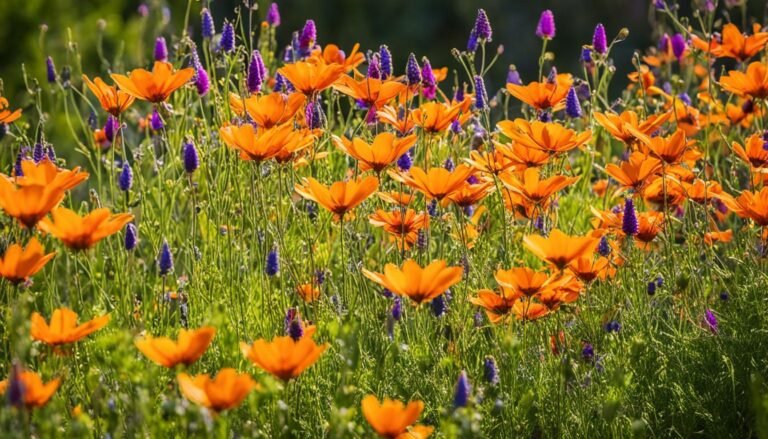As a nature enthusiast, I always find joy in exploring the vibrant colors that adorn our natural landscapes. One particular hue that never fails to catch my eye is the vivid orange of wildflowers. Whether I’m hiking through a meadow or strolling along a woodland trail, the sight of bright orange blooms instantly draws me closer, each petal a testament to the enchanting beauty of nature.
These wild orange flowers, with their vibrant hues and striking appearances, add a burst of energy and warmth to any scenery. They stand out amidst the lush greenery, creating a visual feast that captivates the senses. Each unique blossom tells a story of resilience, adaptability, and natural wonders.
From the delicate petals of the Orange Hawkweed to the fiery brilliance of the Butterfly Weed, the variety of bright orange wildflowers is truly remarkable. They come in all shapes and sizes, ranging from small clusters to tall spikes, adorning our fields, meadows, and gardens with their colorful botanicals.
While some of these wild blooms may be familiar, others may surprise you with their uniqueness and charm. Their presence in our natural landscapes not only adds aesthetic value but also plays a significant role in supporting pollinators and wildlife, making them an essential part of our ecosystems.
Join me on a botanical journey through the United States as we dive into the world of bright orange wildflowers, exploring their growing habits, blooming time, preferred sun exposure, and the significance they hold in our natural world. Together, let’s unravel the beauty and secrets hidden within these striking garden plants and discover the wonders they bring to our surroundings.
Key Takeaways
- Bright orange wildflowers are vibrant and captivating, adding a burst of color to our natural landscapes.
- These wildflowers come in various shapes and sizes, each with its own unique beauty and charm.
- They play a vital role in supporting pollinators and wildlife, making them essential to our ecosystems.
- Exploring the world of bright orange wildflowers provides a deeper appreciation for the beauty of nature.
- Unravel the secrets and wonders of these striking garden plants as we embark on a botanical journey through the United States.
Orange Hawkweed
Orange Hawkweed, also known as Devil’s Paintbrush and Fox-and-cubs, is a vibrant wildflower native to Europe. This beautiful wildflower showcases clusters of small orange flowers that sit atop tall, slender stems. You’ll notice its lance-shaped leaves growing in a basal rosette, adding to its distinctive appearance. Orange Hawkweed is a perennial plant that spreads through rhizomes and seeds, allowing it to establish in various habitats.
This captivating wildflower thrives in well-drained soil and is commonly found in open meadows, roadsides, and disturbed areas. It blooms from late spring to early summer, creating a stunning display of vibrant orange hues. The blooming period coincides with the peak activity of pollinators, such as bees, butterflies, and other beneficial insects, who are attracted to its nectar-rich flowers.
Orange Hawkweed is not known to be toxic to humans or animals. However, it’s worth noting that while this wildflower adds beauty to landscapes, it can become invasive if not properly controlled. Its ability to spread rapidly and outcompete native plants raises concern in certain areas. Therefore, appropriate measures should be taken, such as regular monitoring and management, to prevent its uncontrolled growth and preserve the diversity of native flora.
Key Features of Orange Hawkweed:
- Vibrant wildflower with small orange flowers.
- Tall, slender stems and lance-shaped leaves in basal rosette.
- Blooms from late spring to early summer.
- Thrives in well-drained soil.
- Attracts bees, butterflies, and other pollinators.
- Not known to be toxic to humans or animals.
Discover the enchanting allure of Orange Hawkweed as it brings a pop of vibrant color to landscapes while providing a valuable food source for pollinators.
Spotted Touch-Me-Not
Spotted Touch-Me-Not, also known as Jewelweed, is a distinctive orange wildflower found across North America. It features tubular, pendant-shaped flowers with vibrant orange petals and distinctive reddish-brown spots. The plant has light green, smooth foliage.
Spotted Touch-Me-Not is an annual plant that thrives in moist, shady areas such as woodland edges, damp meadows, and stream banks. It blooms from mid-summer to early fall, adding a splash of coral orange to its surroundings. The tubular flowers are particularly attractive to hummingbirds and butterflies, making it a favorite among pollinators.
One unique characteristic of Spotted Touch-Me-Not is its ability to disperse its seeds forcefully when touched or brushed against, hence its intriguing name. This mechanism ensures the plant’s survival and disperses its seeds to new areas.
Spotted Touch-Me-Not is not toxic to humans or animals and has been historically used for its medicinal properties. Its juice and crushed leaves are believed to provide relief from skin irritations, such as poison ivy rashes. However, it is always recommended to consult a healthcare professional before using any plant-based remedies.
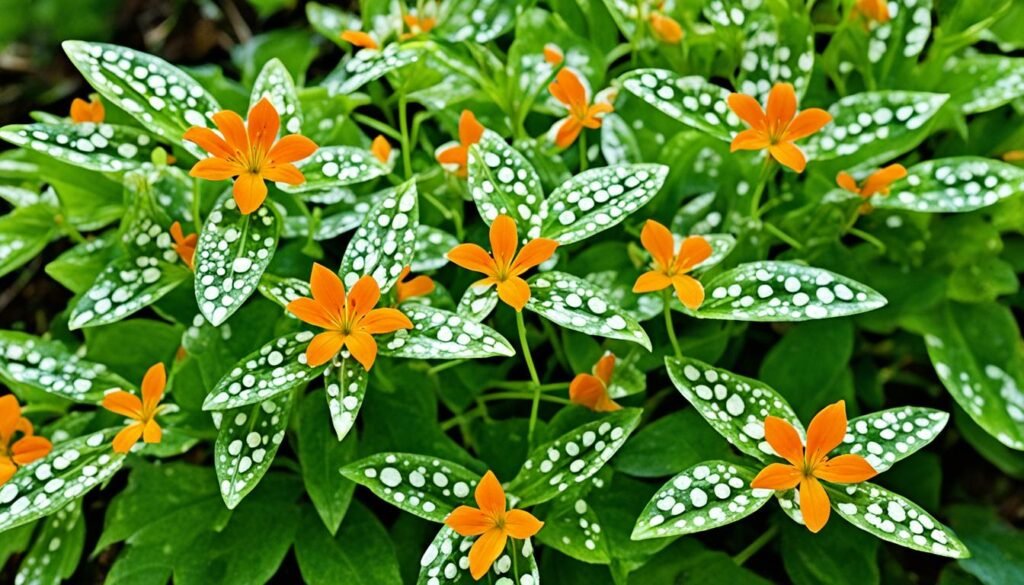
Notable Features of Spotted Touch-Me-Not:
- Tubular pendant-shaped flowers with vibrant orange petals
- Distinctive reddish-brown spots on the petals
- Light green, smooth foliage
- Annual plant that thrives in moist, shady areas
- Blooms from mid-summer to early fall
- Attracts hummingbirds and butterflies
- Non-toxic to humans and animals, with historical medicinal uses
Butterfly Weed
Butterfly Weed, scientifically known as Asclepias tuberosa, is a striking orange wildflower native to North America. This bright orange beauty features clusters of flat-topped, vibrant flowers that bloom in the shape of a rounded umbrella. The lance-shaped, gray-green leaves add to its unique appeal.
Butterfly Weed is a perennial plant that prefers well-drained soil and full sun exposure. It is commonly found in prairies, meadows, and open woodlands. The blooming time for Butterfly Weed is from late spring to mid-summer, delighting the eyes with its stunning display of colorful petals.
One of the remarkable characteristics of Butterfly Weed is its significance to pollinators. As the name suggests, it attracts butterflies, bees, and other pollinators with its nectar-rich flowers. The bright orange blooms act as beacons, inviting these essential creatures to seek nourishment.
Butterfly Weed’s flat-topped clusters of flowers provide a reliable food source for pollinators, supporting their populations and contributing to the ecological balance.
It’s important to note that Butterfly Weed is not toxic. However, consuming large quantities can cause mild stomach upset. Therefore, it’s best to appreciate this wildflower’s beauty without tasting its petals.
The vibrant colors and ecological significance of Butterfly Weed make it a valuable addition to gardens, landscapes, and natural habitats. By planting Butterfly Weed, you can create a haven for pollinators and enjoy the enchanting sight of butterflies fluttering around this bright orange wildflower.
| Butterfly Weed Information | |
|---|---|
| Blooming Time | Late spring to mid-summer |
| Sun Exposure | Full sun |
| Significance to Pollinators | Attracts butterflies, bees, and other pollinators |
| Toxicity | Not toxic but can cause mild stomach upset if eaten in large quantities |
Wood Lily
Wood Lily, scientifically known as Lilium philadelphicum, is a stunning bright orange wildflower native to North America. The Wood Lily is also commonly referred to as the Philadelphia Lily or Prairie Lily.
This beautiful wildflower stands out with its showy, nodding star-shaped flowers. Each blossom features six bright orange petals that form a captivating star shape. These nodding flowers create a graceful and elegant display.
The Wood Lily is a perennial plant that prefers well-drained soil and thrives in areas with full sun exposure. It can also tolerate some partial shade in the afternoon. This stunning wildflower is commonly found in open woods, meadows, and prairies, adding a touch of vibrant color to these natural landscapes.
Wood Lilies typically bloom from late spring to early summer, creating a vibrant burst of color during this time. Their blooming period coincides with the arrival of other pollinators, attracting butterflies, bees, and other important pollinating insects. These wildflowers play a significant role in the reproductive cycle of many plant species and provide a crucial food source for pollinators.
While Wood Lilies are not considered toxic, it’s important to note that some individuals may experience allergic reactions upon contact with the pollen or plant material. Caution should be exercised when handling this wildflower if you have known allergies or sensitivities to lilies.
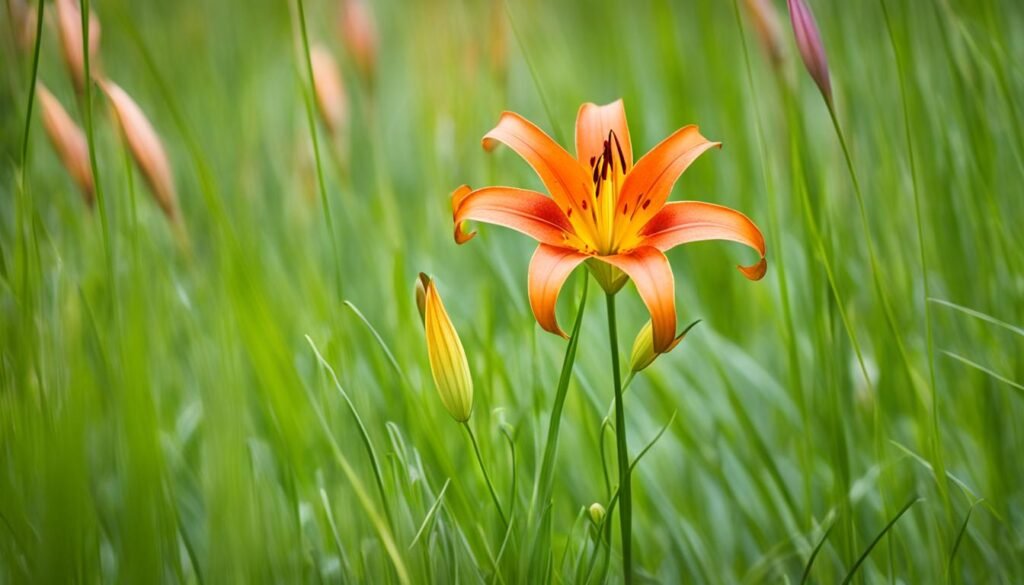
Overall, the Wood Lily is a stunning addition to any garden or natural landscape, bringing vibrant orange hues and nodding star-shaped flowers. Its significance to pollinators and its ability to thrive in various habitats make it a true gem among North American wildflowers.
North Carolina’s Orange Wildflowers: Introduction
Welcome to this comprehensive guide on orange wildflowers found in North Carolina. In this article, we will explore 14 different types of these captivating blooms that dot the landscape of North Carolina. From the striking Tiger Lily to the delicate Flame Azalea, this guide provides detailed descriptions and growing information for each orange wildflower. It also highlights their unique characteristics and uses. Additionally, the guide emphasizes the importance of caution, reminding readers about certain wildflowers that may be toxic or invasive.

Most Common Orange Wildflowers in North Carolina
| No. | Wildflower | Description | Growing Information | Characteristics | Uses | Toxic or Invasive? |
|---|---|---|---|---|---|---|
| 1 | Tiger Lily | A stunning wildflower with vibrant orange petals and dark spots. Known for its tall stems and showy flowers. | Plant in well-drained soil with partial sun exposure. Blooms in mid-summer. | Perennial. Attracts bees and butterflies. Tolerant of deer and rabbits. | Popular in cut arrangements. Adorn gardens and landscapes. | Non-toxic, non-invasive |
| 2 | Flame Azalea | A deciduous shrub with clusters of vibrant orange flowers. Known for its showy display and pleasant fragrance. | Plant in acidic, well-drained soil with filtered sunlight. Blooms in spring. | Shrub. Attracts pollinators. Provides shelter for birds. | Ornamental landscaping. Native plant gardens. Wildlife habitats. | Non-toxic, non-invasive |
Notable Orange Wildflowers in North Carolina
- Indian Paintbrush: A striking wildflower with red-orange bracts and small flowers. Holds cultural significance and adds color to meadows and prairie restorations.
- Butterfly Weed: Also known as Asclepias tuberosa, this orange wildflower attracts butterflies with its nectar-rich flowers.
- Wood Lily: A stunning orange wildflower with star-shaped flowers. Thrives in open woods and attracts pollinators.
“North Carolina’s diverse landscapes are adorned with a variety of captivating orange wildflowers. From the bold Tiger Lily to the delicate Flame Azalea, these blooms add vibrancy to the natural beauty of the state.”
Orange Wildflower #1: Daylily
The daylily, also known as Hemerocallis, is a stunning bright orange wildflower known for its short blooming period. Each flower only lasts one day but produces an abundance of vibrant blooms. Daylilies are relatively easy to grow and can thrive in a variety of conditions.
Characterized by their vibrant pops of orange, daylilies are commonly used in landscaping and gardening to add a burst of color to flower beds and borders. These resilient flowers also offer erosion control and can withstand drought conditions, making them a popular choice for low-maintenance gardens.
Here are some growing information and characteristics of daylilies:
- Scientific Name: Hemerocallis
- Blooming Time: Each flower lasts for one day; multiple blooms throughout the blooming season
- Sun Exposure: Full sun to partial shade
- Growth Habit: Perennial
- Watering: Regular watering, but tolerate short periods of drought
- Soil Requirements: Well-drained soil
- Height: Varies depending on the cultivar (approximately 1-4 feet)
- Flower Shape: Trumpet-shaped or funnel-shaped
- Foliage: Clump-forming, long and strappy leaves
Daylilies not only brighten up the garden but also attract pollinators such as bees and butterflies, making them valuable additions to pollinator-friendly landscapes. Their versatility and stunning display of vibrant orange make them a favorite among garden enthusiasts.

Orange Wildflower #2: Butterfly Weed
Butterfly Weed, scientifically known as Asclepias tuberosa, is a captivating orange wildflower that attracts insects, particularly butterflies, with its nectar-rich flowers. These wildflowers are easy to grow and thrive in well-drained soil and full sun exposure. Besides their ornamental value, Butterfly Weed plays a significant role in supporting pollinators.
Butterfly Weed, with its vibrant orange blooms, acts as a magnet for bees, butterflies, and other beneficial insects. As they sip on the nectar, these pollinators help transfer pollen from flower to flower, aiding in plant reproduction and the overall biodiversity of your garden. By including Butterfly Weed in your landscape, you’re providing vital food sources and habitats for these important creatures.
In addition to its support for pollinators, Butterfly Weed boasts several other desirable characteristics. It is a low-maintenance perennial plant that is drought-tolerant once established. Its clusters of flat-topped flowers bloom from late spring to mid-summer, adding vibrant color to any garden. The lance-shaped, gray-green leaves provide an attractive backdrop to the striking orange blooms.
Butterfly Weed is a versatile plant that can be used in various garden settings. It thrives in butterfly gardens, where its flowers act as a beacon for these beautiful creatures. It also complements native plant gardens, as it is native to North America and contributes to the preservation of local biodiversity. Additionally, Butterfly Weed’s vibrant orange flowers make it an eye-catching addition to natural landscapes, meadows, and prairie gardens.
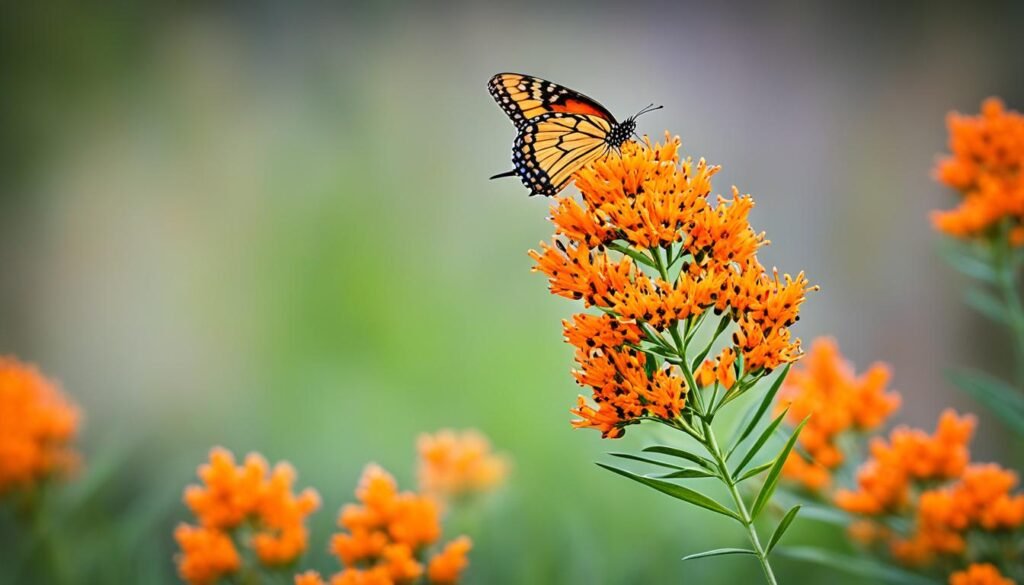
With its ability to attract insects, its low-maintenance nature, and its striking beauty, Butterfly Weed, or Asclepias tuberosa, is a must-have for any garden that aims to support pollinators and add a vibrant touch of orange to the landscape.
Orange Wildflower #3: Indian Paintbrush
Indian Paintbrush, scientifically known as Castilleja coccinea, is a striking orange wildflower native to North America, including North Carolina. These wildflowers get their name from the vibrant red-orange bracts that surround their small flowers. Indian Paintbrush blooms atop tall and slender stems, adding vertical interest to the landscape.
With its striking daisy-like flowers, Indian Paintbrush is a popular choice for ornamental gardens, wildflower meadows, prairie restorations, and native plant gardens. It attracts pollinators such as bees and butterflies, making it a valuable addition to any garden ecosystem.
| Growing Information | Characteristics | Uses |
|---|---|---|
| Sun Exposure: Full sun to partial shade | Height: 1-3 feet | Ornamental Value: The vibrant flowers add a pop of color to any garden. |
| Soil: Well-drained soil | Blooming Time: Late spring to early summer | Cultural Significance: Indian Paintbrush holds cultural significance in Native American folklore. |
| Watering: Moderate watering | Growth Habit: Upright and slender stems |
Indian Paintbrush’s unique appearance and cultural significance make it a cherished part of the North American landscape. Whether grown in a garden or admired in the wild, this striking orange wildflower is sure to capture attention and add a touch of beauty to any setting.
Orange Wildflower #4: Fireweed
Fireweed, scientifically known as Chamerion angustifolium, is a striking orange wildflower with daisy-like flowers that bloom on tall spikes, resembling flames. As a pioneer species, Fireweed often takes the lead in colonizing areas after a fire.
Fireweed is not only admired for its ornamental value but also cherished for its culinary and medicinal properties. Its young shoots, leaves, and flowers are edible and can be used in a variety of dishes, including salads, teas, and infusions. The vibrant orange blooms of Fireweed also play a crucial role in ecological restoration, providing habitat and food for pollinators and wildlife.
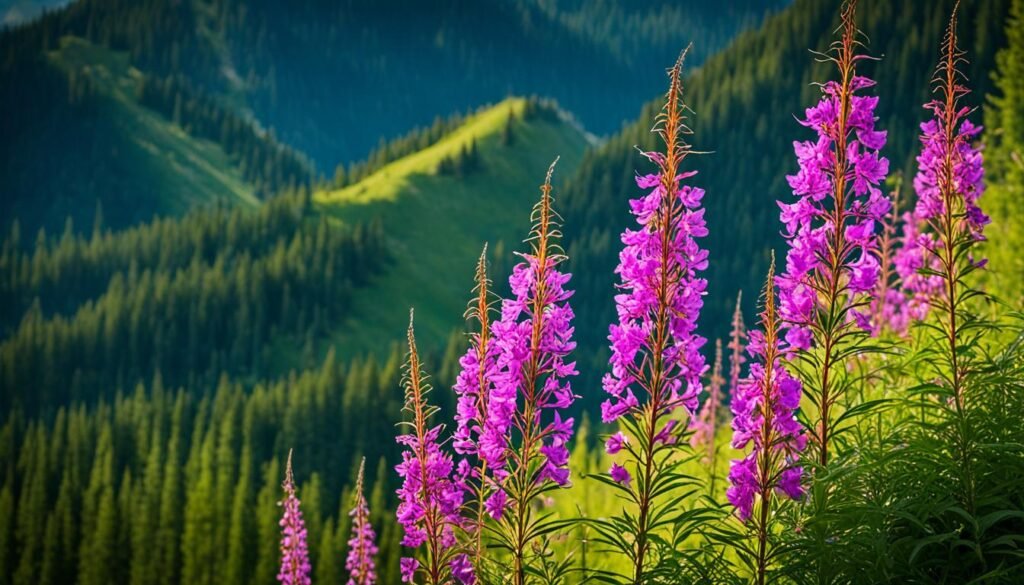
| Characteristics | Growing Information | Uses |
|---|---|---|
| Scientific Name: Chamerion angustifolium | Sun Exposure: Full sun to partial shade | Culinary Uses: Edible shoots, leaves, and flowers |
| Flower Color: Orange | Soil Type: Well-drained | Medicinal Uses: Traditionally used for various ailments |
| Blooming Time: Summer to early fall | Watering: Moderate | Ecological Uses: Pioneer species, habitat and food for pollinators and wildlife |
Conclusion
In conclusion, the presence of bright orange wildflowers brings a vibrant splash of color to the diverse landscapes of the United States, including North Carolina. These wildflowers, with their vibrant colors, add beauty and charm to their surroundings. From the vibrant petals of the Orange Hawkweed to the delicate fringed flowers of the Orange Jewelweed, the sight of these wildflowers captivates the eye.
However, it is essential to exercise caution when encountering these botanical wonders. Some wildflowers may be toxic or invasive, posing potential risks to humans and the environment. It is crucial to be aware of the potential dangers and appreciate these flowers from a safe distance.
Aside from their aesthetic appeal, these bright orange wildflowers hold ecological significance. They play a vital role in supporting pollinators, such as bees and butterflies, by providing them with a source of nectar and pollen. These wildflowers contribute to the preservation of the ecosystem by promoting biodiversity and ensuring the continuation of plant pollination.
Discovering the wonders of bright orange wildflowers in the United States is an opportunity to appreciate the beauty of nature and the ecological importance of these fascinating blooms. So, let us explore the diverse landscapes and celebrate the vibrant colors and ecological significance of these bright orange wildflowers.
